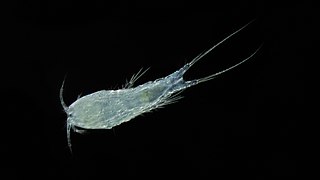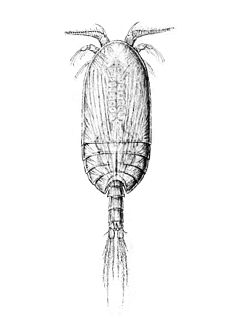
Diaptomus is a genus of copepods with a single eye spot. It is superficially similar in size and appearance to Cyclops. However it has characteristically very long first antennae that exceed the body length. In addition, the females carry the eggs in a single sac rather than the twin sacs seen in Cyclops. It is a copepod of larger freshwater ponds, lakes and still waters.

Canthocamptus is a genus of copepods that live in water from the Arctic Ocean to the Atlantic Ocean. There are over 200 different species of Canthocamptus. A number of Australian endemic species are listed as vulnerable species on the IUCN Red List, and one Brazilian species is conservation dependent.
Aglaodiaptomus is a genus of copepods in the family Diaptomidae. They are often bright red or blue due to carotenoid pigments.
Allodiaptomus is a genus of copepods in the family Diaptomidae, containing the following species:
Arctodiaptomus kamtschaticus is a species of crustacean in the family Diaptomidae. It is endemic to lakes in Kamchatka, eastern Russia, and is listed as a vulnerable species on the IUCN Red List.
Boeckella is a genus of copepods in the family Centropagidae.
Dussartius baeticus is a species of crustacean in the family Diaptomidae. It is endemic to the Iberian Peninsula, having been found in south-eastern Spain, and in the waters of the Tagus estuary, the Caniçada reservoir, and four reservoirs in the Mondego system in Portugal.
Eodiaptomus lumholtzi is a species of copepod endemic to Australia. It is one of only two species in the family Diaptomidae to occur in Australia, the other being Tropodiaptomus australis. It is listed as a vulnerable species on the IUCN Red List.
Heliodiaptomus pulcher is a species of copepod in the family Diaptomidae. It is endemic to India.
Hemiboeckella powellensis is a species of copepod endemic to Lake Powell, Western Australia. It is listed as a vulnerable species on the IUCN Red List. It was first described by I. A. E. Bayly in 1979. No females have been found.
Hesperodiaptomus is a genus of copepods in the family Diaptomidae, containing 18 species. Two species – H. augustaensis and H. californiensis – are endemic to the United States and listed as vulnerable species on the IUCN Red List.
Paradiaptomus simplex is a species of copepod in the family Diaptomidae. It is endemic to South Africa.
Mastigodiaptomus is a genus of Neotropical copepods in the family Diaptomidae. Two of the eight species in the genus are listed as Data Deficient (DD) on the IUCN Red List, and one is listed as a vulnerable species (VU):
Neodiaptomus is a genus of freshwater copepods in the family Diaptomidae. It contains the following species, four of which are listed as vulnerable species on the IUCN Red List :
Neutrodiaptomus is a genus of copepods in the family Diaptomidae. The Japanese endemic species N. formosus is listed as Data Deficient on the IUCN Red List. The genus Neutrodiaptomus contains the following species:
Notodiaptomus is a genus of copepods in the family Diaptomidae. It is the most widely distributed, most abundant and most species-rich genus of freshwater calanoid copepods in the Neotropics. The genus was erected in 1936 by Friedrich Kiefer for eleven species formerly placed in a wider Diaptomus. Notodiaptomus deitersi was chosen to be the type species by Raúl Adolfo Ringuelet in 1958.
Skistodiaptomus is a genus of freshwater copepods in the family Diaptomidae, found across North America. The genus contains eight species, three of which are endemic to the United States and are listed on the IUCN Red List as vulnerable species (VU) or Data Deficient (DD).
Thermodiaptomus is a genus of copepods in the family Diaptomidae, containing the following species:
Tropodiaptomus is a genus of copepods in the family Diaptomidae. It includes the following species, many of which are narrow endemics and are included on the IUCN Red List :

Platycopiidae is a family of copepods. Until the description of Nanocopia in 1988, it contained the single genus Platycopia. It now contains four genera, three of which are monotypic; the exception is Platycopia, with 8 species.
 [4]
[4]  [5]
[5]  [6]
[6] 

